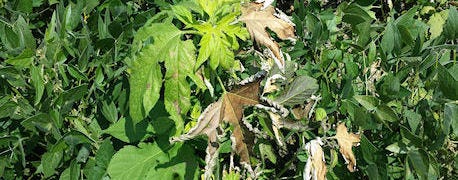
Look at the picture below and you may be encouraged, at least at first. This is a picture of a giant ragweed after being sprayed with glyphosate. You've heard the horror stories about glyphosate resistant giant ragweed that you can't kill, even with four or more applications of glyphosate, the active ingredient in Roundup, also sold under many generic herbicide names.
Related: Don't neglect marestail, giant ragweed and waterhemp to tackle Palmer amaranth

Early burn: Note necrosis and die-back on the edge of leaves on this giant ragweed soon after spraying with glyphosate. Unfortunately, the weed quickly recovers and is back on its merry way. (Photo courtesy of Bill Johnson, Purdue University Extension weed control specialist)
While it looks like the plant in the picture is headed toward a quick death, even quicker than normally occurs with glyphosate, since the symptoms of a dying plant sometimes take a while to appear, nothing could be farther from the truth. In fact, Johnson, the Purdue University Extension weed control specialist and other weed control specialists from around the Midwest who have documented this phenomenon say it's actually worse than dealing with the normal form of glyphosate-resistant giant ragweed.
How could that be? It certainly looks like its demise isn't very far away in this photo. Therein lies the problem, Johnson says. He notes that this is as much damage as usually occurs after the herbicide application. Instead of leaves continuing to show signs of death, or necrosis, including signs of browning and burning, the plants showing these symptoms instead quickly regrow. They're back off to growing and competing with the crop in short order.
Compared to plants with resistance but not this early-necrosis type of resistance, the early necrosis type returns to growing and competing faster after a glyphosate application on both, Johnson explains. Sometimes a weed will be at least stunted or slowed down for a while – the early necrosis type isn't slowed down as much before it is back to growing and becoming even more competitive.
Johnson and other weed control specialists are still studying this phenomenon. They are looking for ways to identify and know for sure that a plant showing similar symptoms is in fact of the early necrosis biotype.
Related: Try Early Burndown To Control Giant Ragweed
The bottom line is what first looked like a good thing is definitely not, it's just one more reason to plan an effective control strategy against giant ragweed, Johnson notes.
About the Author(s)
You May Also Like




